实例介绍
【实例截图】

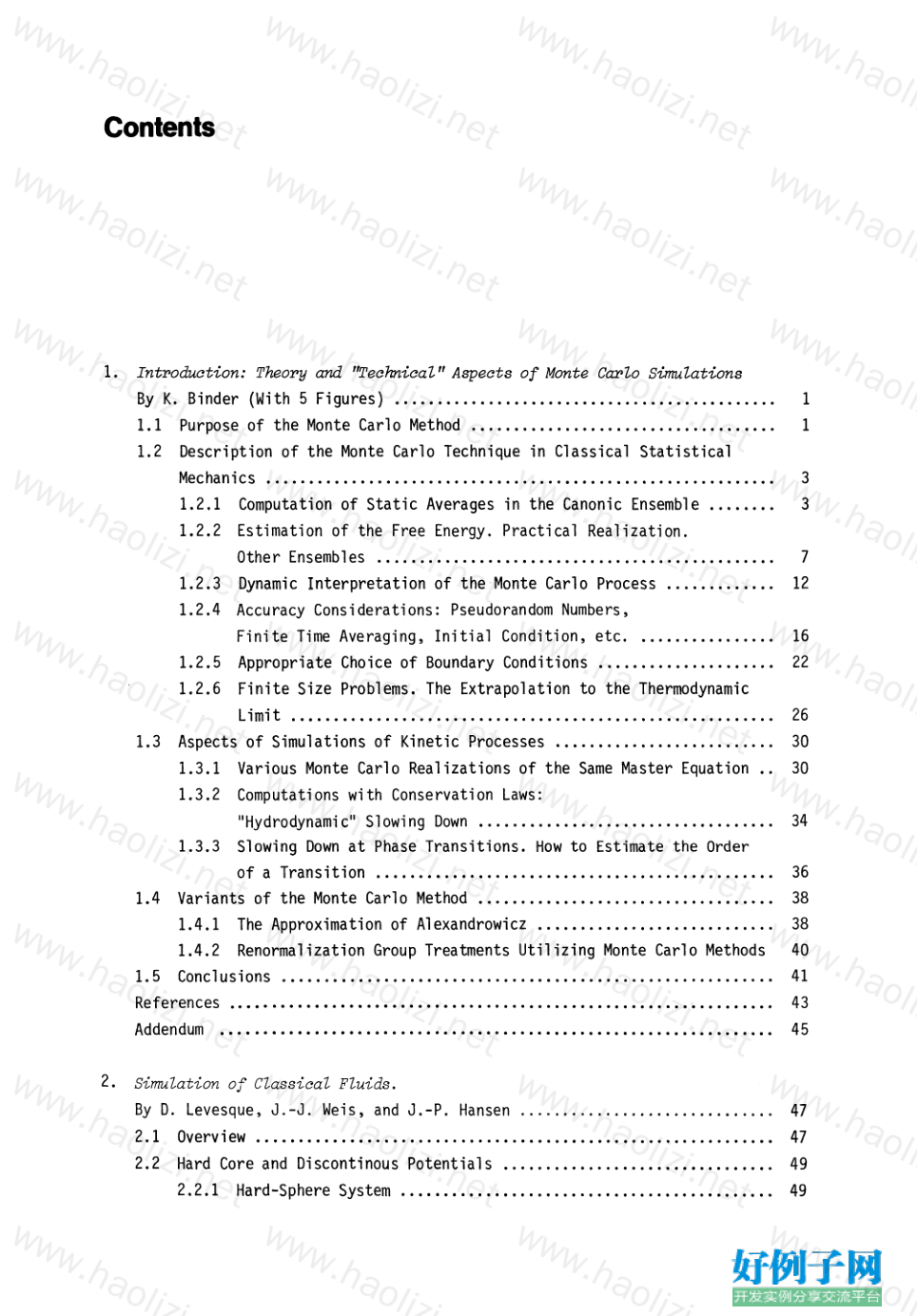
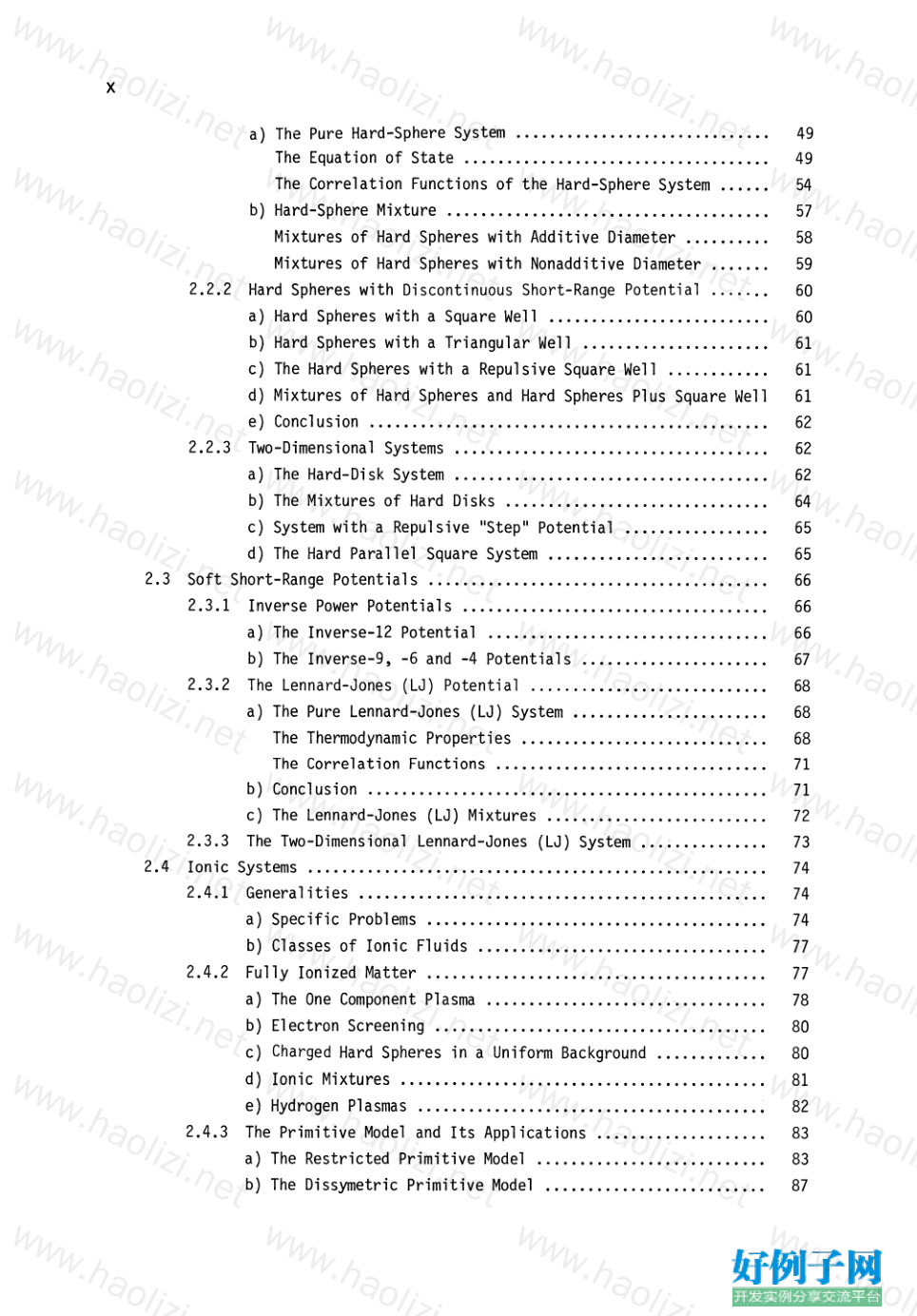
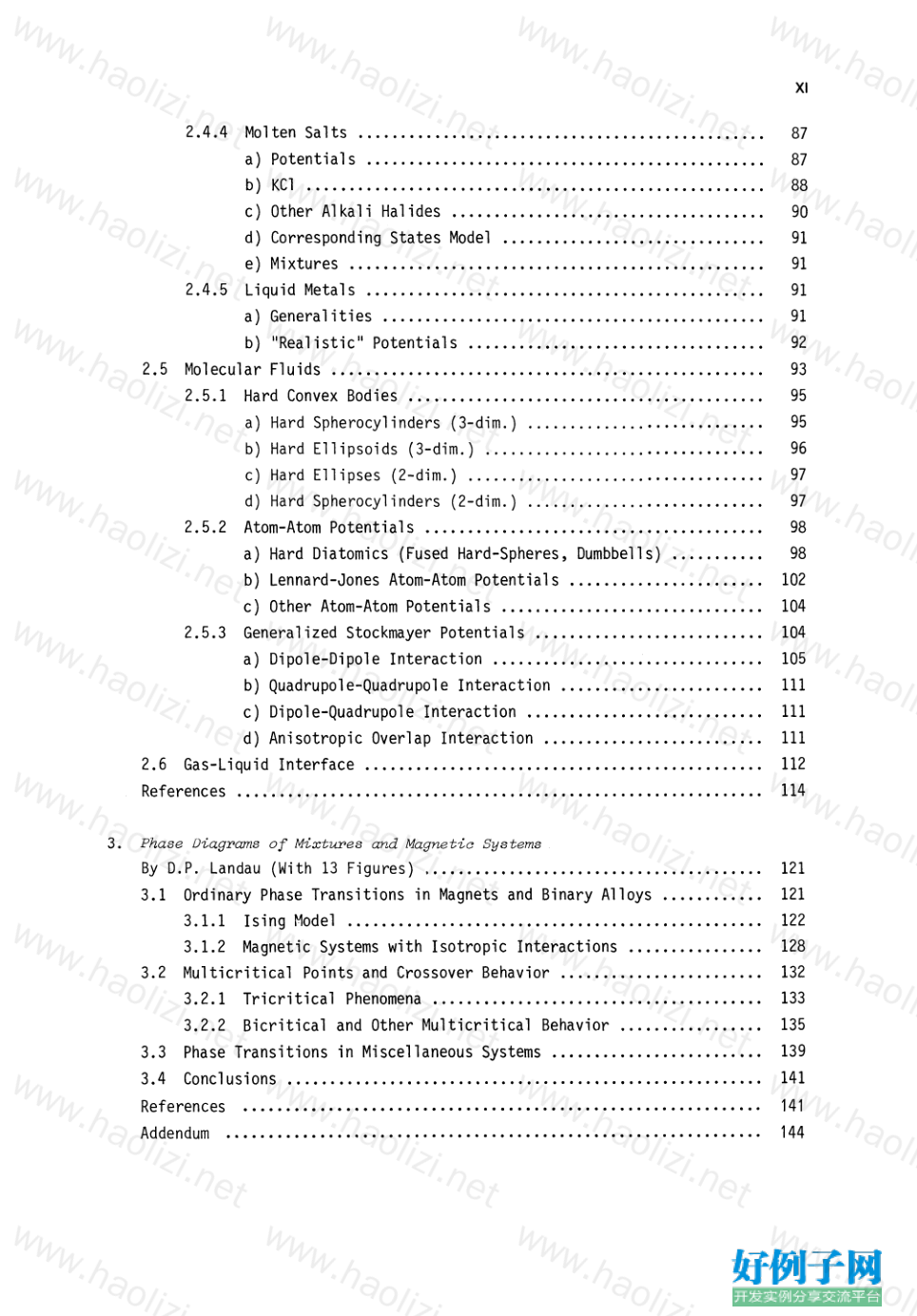
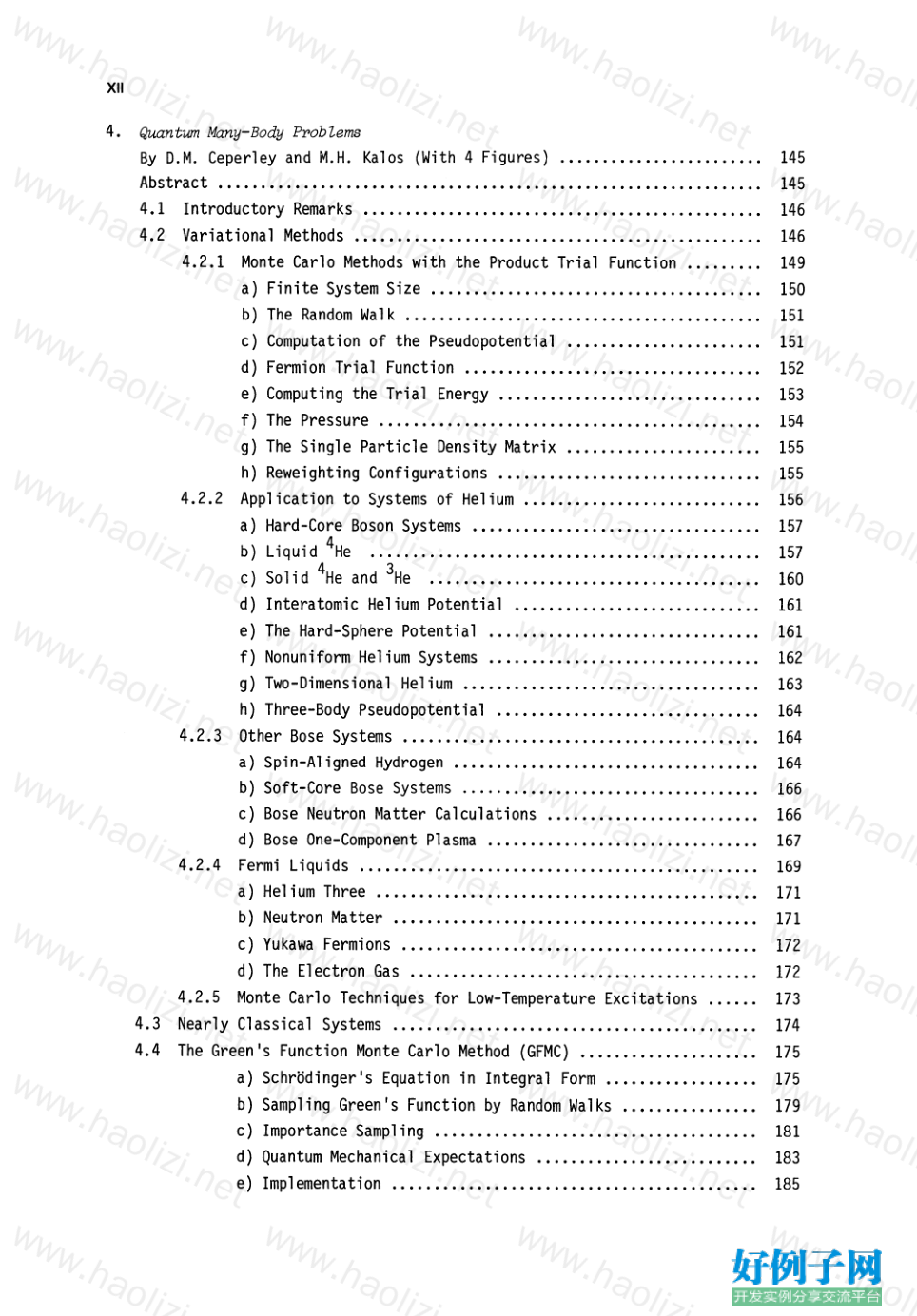

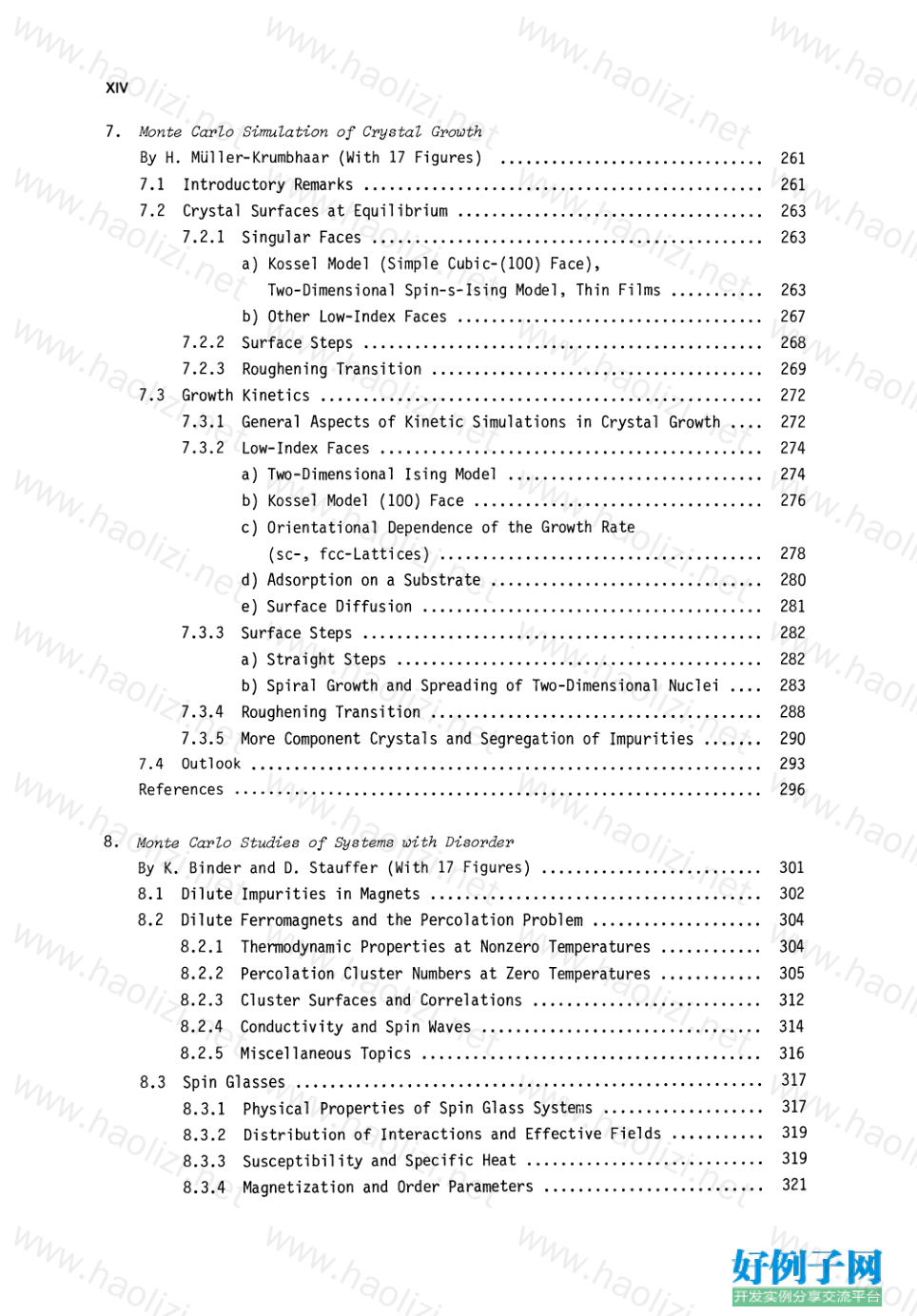
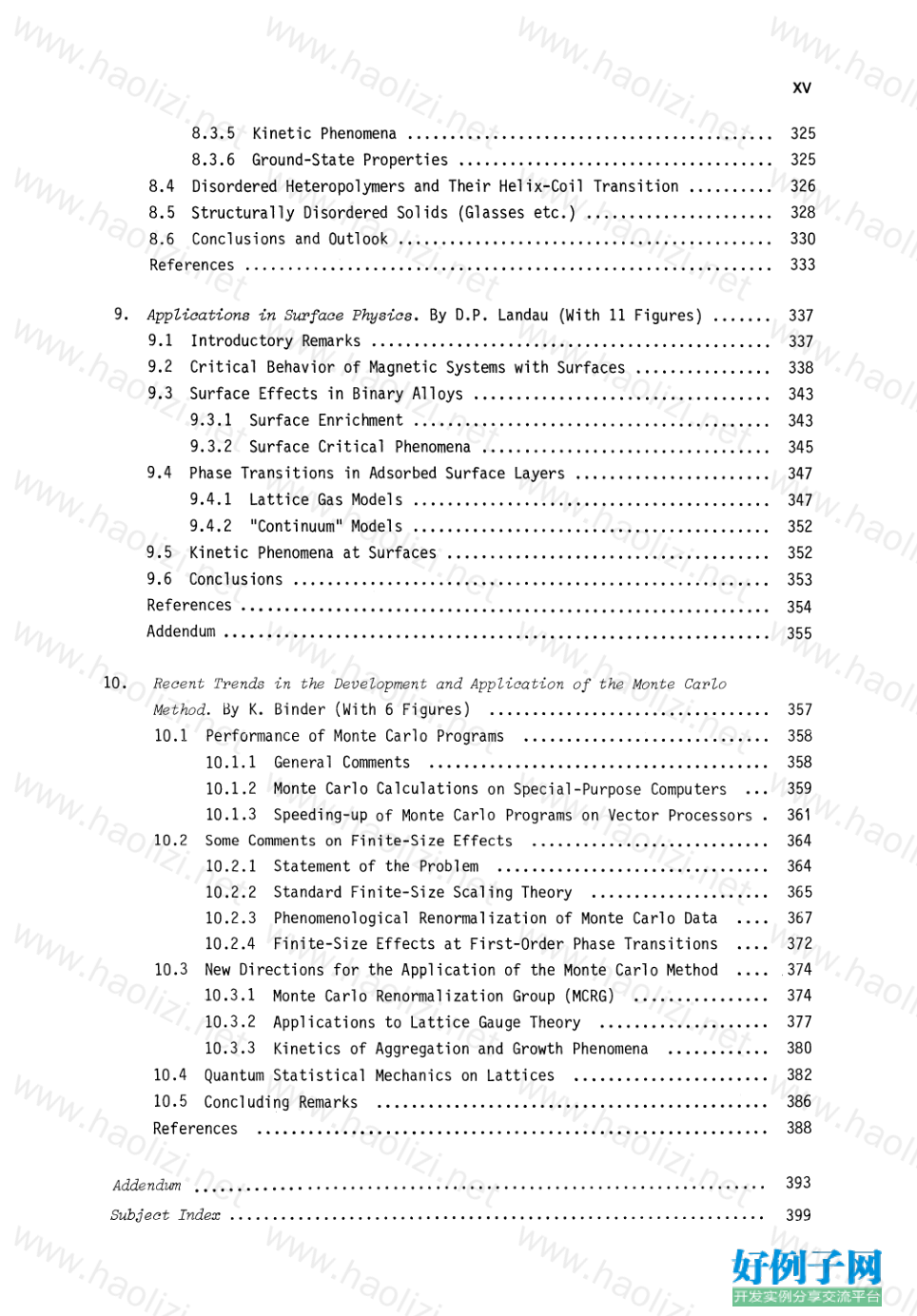
【核心代码】
Contents
1. Introduction: Theory and "TechnicaZ" Aspects of Monte CarZo SirrruZations
By K. Binder (With 5 Figures) ............................................. 1
1.1 Purpose of the Monte Carlo Method .................................... 1
1.2 Description of the Monte Carlo Technique in Classical Statistical
Mechanics............................................................ 3
1.2.1 Computation of Static Averages in the Canonic Ensemble ........ 3
1.2.2 Estimation of the Free Energy. Practical Realization.
Other Ensembles ............................................... 7
1.2.3 Dynamic Interpretation of the Monte Carlo Process
1.2.4 Accuracy Considerations: Pseudorandom Numbers,
12
Finite Time Averaging, Initial Condition, etc. ................ 16
1.2.5 Appropriate Choice of Boundary Conditions..................... 22
1.2.6 Finite Size Problems. The Extrapolation to the Thermodynamic
Limit ......................................................... 26
1.3 Aspects of Simulations of Kinetic Processes .......................... 30
1.3.1 Various Monte Carlo Realizations of the Same Master Equation 30
1.3.2 Computations with Conservation Laws:
"Hydrodynamic" Slowing Down................................... 34
1.3.3 Slowing Down at Phase Transitions. How to Estimate the Order
of a Transition ............................................... 36
1.4 Variants of the Monte Carlo Method ................................... 38
1.4.1 The Approximation of Alexandrowicz ..•......................... 38
1.4.2 Renormalization Group Treatments Utilizing Monte Carlo Methods 40
1.5 Conclusions .......................................................... 41
References ...............•................................................ 43
Addendum .............••..............•................................... 45
2. SimuZation of CZassicaZ FZuids.
By D. Levesque, J.-J. Weis, and J.-P. Hansen .............................. 47
2.1 Overview ............................................................. 47
2.2 Hard Core and Discontinous Potentials ...................•............ 49
2.2.1 Hard-Sphere System ............•............................... 49
x
a) The Pure Hard-Sphere System ........•...............•..... 49
The Equation of State .................................... 49
The Correlation Functions of the Hard-Sphere System ...... 54
b) Hard-Sphere Mixture ....•..•.....•.....•...•.•............ 57
Mixtures of Hard Spheres with Additive Diameter ..•.•••... 58
Mixtures of Hard Spheres with Nonadditive Diameter 59
2.2.2 Hard Spheres with Discontinuous Short-Range Potential....... 60
a) Hard Spheres with a Square Well.......................... 60
b) Hard Spheres with a Triangular Well...................... 61
c) The Hard Spheres with a Repulsive Square Well............ 61
d) Mixtures of Hard Spheres and Hard Spheres Plus Square Well 61
e) Conclusion............................................... 62
2.2.3 Two-Dimensional Systems..................................... 62
a) The Hard-Disk System..................................... 62
b) The Mixtures of Hard Disks .......•....................... 64
c) System with a Repulsive "Step" Potential................. 65
d) The Hard Parallel Square System .•..•....•................ 65
2.3 Soft Short-Range Potentials ...........•.•.....•...•................ 66
2.3.1 Inverse Power Potentials ............•...• .••••....... ....... 66
a) The Inverse-12 Potential................................. 66
b) The Inverse-9, -6 and -4 Potentials .•.......•..........•. 67
2.3.2 The Lennard-Jones (LJ) Potential............................ 68
a) The Pure Lennard-Jones (LJ) System •.....•................ 68
The Thermodynamic Properties ........••............•...... 68
The Correlation Functions ...........•.................... 71
b) Conclusion............................................... 71
c) The Lennard-Jones (LJ) Mixtures .......................... 72
2.3.3 The Two-Dimensional Lennard-Jones (LJ) System ......•........ 73
2.4 Ionic Systems...................................................... 74
2.4.1 Generalities. .•..................... .•...................... 74
a) Specific Problems........................................ 74
b) Classes of Ionic Fluids ......................•....•...... 77
2.4.2 Fully Ionized Matter........................................ 77
a) The One Component Pl asma .......•......•.••............... 78
b) El ectron Screeni ng ...........••......•..•................ 80
c) Charged Hard Spheres in a Uniform Background ..........•.. 80
d) Ionic Mixtures........................................... 81
e) Hydrogen Plasmas......................................... 82
2.4.3 The Primitive Model and Its Applications .................... 83
a) The Restricted Primitive Model........................... 83
b) The Dissymetric Primitive Model ....•............•........ 87
XI
2.4.4 Mo 1 ten Sa 1 ts ................................................ 87
a) Potentials............................................... 87
b) KCl ...................................................... 88
c) Other Al kal i Hal ides..................................... 90
d) Corresponding States Model............................... 91
e) Mi xtures ................................................. 91
2.4.5 Liquid Metals............................................... 91
a) Genera 1 it i es ............................................. 91
b) IIRealistic ll Potentials.. .......... ...... ............ ..... 92
2.5 Molecular Fluids................................................... 93
2.5.1 Hard Convex Bodies.......................................... 95
a) Hard Spherocylinders (3-dim.) ........ ... ................. 95
b) Hard Ell ipsoids (3-dim.) ................................. 96
c) Hard Ellipses (2-dim.) ................................... 97
d) Hard Spherocyl inders (2-dim.) ............................ 97
2.5.2 Atom-Atom Potentials........................................ 98
a) Hard Diatomics (Fused Hard-Spheres, Dumbbells) . ..... ..... 98
b) Lennard-Jones Atom-Atom Potentials ....................... 102
c) Other Atom-Atom Potentials ............................... 104
2.5.3 Generalized Stockmayer Potentials ........................... 104
a) Dipole-Dipole Interaction................................ 105
b) Quadrupole-Quadrupole Interaction ........................ 111
c) Dipole-Quadrupole Interaction ............................ 111
d) Anisotropic Overlap Interaction .......................... 111
2.6 Gas-Liquid Interface............................................... 112
References .............................................................. 114
3. Phase Diagrams of Mixtures and Magnetic Systems
By D. P. Landau (With 13 Figures) ........................................ 121
3.1 Ordinary Phase Transitions in Magnets and Binary Alloys ............ 121
3.1.1 Ising ~ 1 o d e l ................................................. 122
3.1.2 Magnetic Systems with Isotropic Interactions ................ 128
3.2 Multicritical Points and Crossover Behavior........................ 132
3.2.1 Tricritical Phenomena....................................... 133
3.2.2 Bicritical and Other Multicritical Behavior................. 135
3.3 Phase Transitions in Miscellaneous Systems......................... 139
3.4 Conclusions........................................................ 141
References ... . . . . . . . . . . . . . . . . . . . . . . . . . . . . . . . . . . . . . . . . . . . . . . . . . . . . . . . . . . 141
Addendum ............................................................... 144
XII
4. Quantwn Many-Body Probl-ems
By D.M. Ceperley and M.H. Kalos (With 4 Figures) .•.•..................•. 145
Abstract ••.....•...•.....••........•..•.....•...•.••......•.•........... 145
4.1 Introductory Remarks............................................... 146
4.2 Variational Methods ..•.•.•••••.......•.••••...•.•••...........•.... 146
4.2.1 Monte Carlo Methods with the Product Trial Function ......•.. 149
a) Finite System Size....................................... 150
b) The Random Walk .................•.....................•.. 151
c) Computation of the Pseudopotential •.••.•................. 151
d) Fermion Trial Function................................... 152
e) Computing the Trial Energy ....•••..•..•.•.•.••..........• 153
f) The Pressure .•.•••••••.•••••••••....•••.••.•......•.•.•.• 154
g) The Single Particle Density Matrix ...••..•......•......•. 155
h) Rewei ghting Configurations •.....•.........•......•....•.. 155
4.2.2 Application to Systems of Helium ...•...............••....... 156
a) Hard-Core Boson Systems ••..••••.•••...•.....•.....•.•..•• 157
b) Liquid 4 He .........•...•.•...................•.........• 157
c) Solid 4 He and 3 He .................... ••.•... ..... ....... 160
d) Interatomic Helium Potential.............. ... .....• .•.... 161
e) The Hard-Sphere Potential •..••••••.....•.•.•..•....••.•.. 161
f) Nonuniform Hel ium Systems •.........••..............•..... 162
g) Two-Dimensional Hel ium .....•..•...••...•...........•..... 163
h) Three-Body Pseudopotential ...••.••.•.....•........•...... 164
4.2.3 Other Bose Systems.......................................... 164
a) Spin-Al igned Hydrogen .•.•.•.•.•...•.••.••.••.......•..... 164
b) Soft-Core Bose Systems .......•...•.........•............. 166
c) Bose Neutron Matter Calculations ....••..•...............• 166
d) Bose One-Component Plasma .••.•...•..••.•...•..........•.• 167
4.2.4 Fermi Liquids.... .•.••..•.. ....•• .•. .•.••............... •... 169
a) Hel ium Three............................................. 171
b) Neutron Matter........................................... 171
c) Yukawa Fermions .............•.•.•..••.••................. 172
d) The Electron Gas......................................... 172
4.2.5 Monte Carlo Techniques for Low-Temperature Excitations ...... 173
4.3 Nearly Classical Systems........................................... 174
4.4 The Green's Function Monte Carlo Method (GFMC) .•.•••.••..•......... 175
a) Schrodinger's Equation in Integral Form ..•....•.....•.... 175
b) Sampling Green's Function by Random Walks ..•...•.•......• 179
c) Importance Samp 1 i ng •.•.......•.........................•. 181
d) Quantum Mechanical Expectations ................••.....••. 183
e) Implementation........................................... 185
XIII
4.4.1 Results........... .......................................... 186
4.5 Vi rial Coefficients and Pair Correlations .•..•..•..•.••......•....• 190
4.6 Conclusions........................................................ 191
References ................•.•.•.....•..••.•••.•.•...•.•.....•.•....••..• 192
5. SimuZation of Smazz Systems. By H. MUller-Krumbhaar (With 9 Figures) .•.. 195
5.1 Introductory Remarks .•.•.......•.••..•..•..•...•......••.•.......•. 195
5.2 Statics............................................................ 197
5.2.1 Clusters in Continuous Space ..•...•....•.....•..•.••...•..•. 197
5.2.2 Lattice Models.............................................. 199
a) General Remarks •....•..•.•.•........•....•...•........... 199
b) Finite-Size Behavior and Superparamagnetism .........•.... 200
c) Equilibrium Cluster Statistics in Systems with Interaction 204
d) Cluster Statistics in the Percolation Problem ......•..... 210
5.3 Cluster Dynamics................................................... 213
5.3.1 First-Order Phase Transitions .....•.....•................•.. 213
5.3.2 Second-Order Transitions.................................... 216
Appendix .•..••.........•...•..................•..•............•......•.. 219
Cluster Counting Algorithm.............................................. 219
References ...•.•........•.•.................•........•........•......•.. 221
Addendum •••. . . . • . . . . • • . • . . . . • . . . . . . • . . • • . . . • • • • . . • . . . • • . . • . . . . • • . . . . . . . • 223
6. Monte CarZa Studies of ReZaxation Phenomena: Kinetics of Phase Changes
and CriticaZ SZowing Down. By K. Binder and M.H. Kalos (With 15 Figures) 225
6.1 Introductory Remarks ..•.......•.•..•...•..•....•.............•....• 225
6.2 Kinetics of Fluctuations in Thermal Equilibrium •.••.•...•.......... 228
6.2.1 Dynamics of Models for Chain Molecules ...••...............•. 228
6.2.2 Critical Slowing Down in Systems Without Conservation Laws.. 230
6.2.3 Relaxation in Systems with Conserved Quantities .......•..... 232
6.2.4 Dynamics at a Multicritical Point .....••...•.........••.••.. 234
6.2.5 Dynamics of "Clusters": Their Reaction Rate
and Diffusion Constant...................................... 235
6.3 Kinetics of Nonlinear Relaxation ..........•.......•..•........•.... 238
6.3.1 Nonlinear Critical Slowing Down ••••.••••••.•••.••••.•....•.. 238
6.3.2 Nucleation Kinetics at First-Order Phase Transitions •••.•.•. 239
6.3.3 Kinetics of Spinodal Decomposition and Grain Growth in Alloys 248
6.4 Conclusions and Outlook............................................ 253
References ..•.•••.•••.•.....•.•......•......•.•...........•.•...•.•.•..• 258
XIV
7. Monte Carlo Simulation of Crystal Growth
By H. MUller-Krumbhaar (With 17 Figures) ............................... 261
7.1 Introductory Remarks ............................................... 261
7.2 Crystal Surfaces at Equil ibrium .................................... 263
7.2.1 Singular Faces.............................................. 263
a) Kassel Model (Simple Cubic-(100) Face),
Two-Dimensional Spin-s-Ising Model, Thin Films ........... 263
b) Other Low-Index Faces.................................... 267
7.2.2 Surface Steps ............................................... 268
7.2.3 Roughening Transition ....................................... 269
7.3 Growth Kinetics.................................................... 272
7.3.1 General Aspects of Kinetic Simulations in Crystal Growth .... 272
7.3.2 Low-Index Faces............................................. 274
a) Two-Dimensional Ising Model .............................. 274
b) Kassel Model (100) Face.................................. 276
c) Orientational Dependence of the Growth Rate
(sc-, fcc-Lattices) ...................................... 278
d) Adsorption on a Substrate ................................ 280
e) Surface Diffusion........................................ 281
7.3.3 Surface Steps ............................................... 282
a) Stra i ght Steps ........................................... 282
b) Spiral Growth and Spreading of Two-Dimensional Nuclei .... 283
7.3.4 Roughening Transition ....................................... 288
7.3.5 More Component Crystals and Segregation of Impurities ....... 290
7.4 Outlook............................................................ 293
References .............................................................. 296
8. Monte Carlo Studies of Systems with Disorder
By K. Binder and D. Stauffer (With 17 Figures) .......................... 301
8.1 Dilute Impurities in Magnets....................................... 302
8.2 Dilute Ferromagnets and the Percolation Problem .................... 304
8.2.1 Thermodynamic Properties at Nonzero Temperatures ............ 304
8.2.2 Percolation Cluster Numbers at Zero Temperatures ............ 305
8.2.3 Cluster Surfaces and Correlations ........................... 312
8.2.4 Conductivity and Spin Waves ................................. 314
8.2.5 Miscellaneous Topics........................................ 316
8.3 Spin Glasses....................................................... 317
8.3.1 Physical Properties of Spin Glass Systems................... 317
8.3.2 Distribution of Interactions and Effective Fields ........... 319
8.3.3 Susceptibility and Specific Heat ............................ 319
8.3.4 Magnetization and Order Parameters .......................... 321
xv
8.3.5 Kinetic Phenomena........................................... 325
8.3.6 Ground-State Properties..................................... 325
8.4 Disordered Heteropolymers and Their Helix-Coil Transition .......... 326
8.5 Structurally Disordered Solids (Glasses etc.) ...................... 328
8.6 Conclusions and Outlook............................................ 330
References .............................................................. 333
9. Applications in Surface Physics. By D.P. Landau (With 11 Figures) ....... 337
9.1 Introductory Remarks............................................... 337
9.2 Critical Behavior of Magnetic Systems with Surfaces ................ 338
9.3 Surface Effects in Binary Alloys ................................... 343
9.3.1 Surface Enrichment .......................................... 343
9.3.2 Surface Critical Phenomena.................................. 345
9.4 Phase Transitions in Adsorbed Surface Layers....................... 347
9.4.1 Lattice Gas Models.......................................... 347
9.4.2 "Continuum" Models.......................................... 352
9.5 Kinetic Phenomena at Surfaces ...................................... 352
9.6 Conclusions........................................................ 353
References ..•........................................................... 354
Addendum ................................................................ 355
10. Recent Trends in the Development and Application of the Monte Carlo
Method. tly K. Binder (With 6 Figures) ................................. 357
10.1 Performance of Monte Carlo Programs ............................. 358
10.2
10.1.1 Genera 1 Comments .. .. .. . .. . .. . .. . . .. . . .. . .. . .. .. . . . .. . .. . 358
10.1.2 Monte Carlo Calculations on Special-Purpose Computers 359
10.1.3 Speeding-up of Monte Carlo Programs on Vector Processors.
Some Comments on Finite-Size Effects
361
364
10.2.1 Statement of the Problem ................................ 364
10.2.2 Standard Finite-Size Scal ing Theory ..................... 365
10.2.3 Phenomenological Renormalization of Monte Carlo Data 367
10.2.4 Finite-Size Effects at First-Order Phase Transitions 372
10.3 New Directions for the Application of the Monte Carlo Method 374
10.3.1 Monte Carlo Renormalization Group (MCRG) ................ 374
10.3.2 Applications to Lattice Gauge Theory .................... 377
10.3.3 Kinetics of Aggregation and Growth Phenomena
10.4 Quantum Statistical Mechanics on Lattices
10.5 Concluding Remarks
References
Addendum ...................................................................
380
382
386
388
393
Subject Index ............................................................... 399
标签: monte Carlo Physics stat car ICA
小贴士
感谢您为本站写下的评论,您的评论对其它用户来说具有重要的参考价值,所以请认真填写。
- 类似“顶”、“沙发”之类没有营养的文字,对勤劳贡献的楼主来说是令人沮丧的反馈信息。
- 相信您也不想看到一排文字/表情墙,所以请不要反馈意义不大的重复字符,也请尽量不要纯表情的回复。
- 提问之前请再仔细看一遍楼主的说明,或许是您遗漏了。
- 请勿到处挖坑绊人、招贴广告。既占空间让人厌烦,又没人会搭理,于人于己都无利。
关于好例子网
本站旨在为广大IT学习爱好者提供一个非营利性互相学习交流分享平台。本站所有资源都可以被免费获取学习研究。本站资源来自网友分享,对搜索内容的合法性不具有预见性、识别性、控制性,仅供学习研究,请务必在下载后24小时内给予删除,不得用于其他任何用途,否则后果自负。基于互联网的特殊性,平台无法对用户传输的作品、信息、内容的权属或合法性、安全性、合规性、真实性、科学性、完整权、有效性等进行实质审查;无论平台是否已进行审查,用户均应自行承担因其传输的作品、信息、内容而可能或已经产生的侵权或权属纠纷等法律责任。本站所有资源不代表本站的观点或立场,基于网友分享,根据中国法律《信息网络传播权保护条例》第二十二与二十三条之规定,若资源存在侵权或相关问题请联系本站客服人员,点此联系我们。关于更多版权及免责申明参见 版权及免责申明



网友评论
我要评论